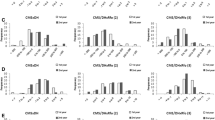Summary
Heterosis and epistasis in spring oilseed rape (Brassica napus L.) was analysed by comparing generation means for ten agronomic traits. Parents, F2, F3 and F6 generations of four crosses with Swedish and French material were investigated. The F2 was 11% higher in yield, earlier in flowering time, and slightly later in maturation when compared with the parents. Randomly derived single seed descent lines had an 8% lower yield, were later flowering and maturing than the parents in F6. This poorer average performance of recombinant lines is explained by the loss of favourable epistatic interactions present in the parents.
Similar content being viewed by others
References
Becker, H.C., 1987. Quantitative Genetik und Zuchtmethodik bei Raps. Ber. Arb. tagung 1987 A.G. Saatzuchtleiter, Gumpenstein: 67–82.
Downey, R.K. & G., Röbbelen, 1989. Brassica species. In: G., Röbbelen, R.K., Downey & A., Ashri, (Eds.). Oil crops of the world. Mc Graw-Hill, New York.
Gallais, A., 1979. Le concept de valeur en lignée et son utilisation possible en sélection. Ann. Amélior. Plantes 29: 1–22.
Lefort-Buson, M. & Y., Dattee, 1982. Genetic study of some agronomic characteris in winter oilseed rape Brassica napus L. I. Heterosis. Agronomie 2 (4): 19–30.
Mather, K. & J.L., Jinks, 1982. Brometrical Genetics. 3rd ed. Chapman and Hall, London
Riggs, T.J. & T.W., Snape, 1977. Effects of linkage and interaction in a comparison of theoretical populations derived by diploidized haploid and SSD methods. Theor. Appl. Genet. 49: 111–115.
Seehuber, R., J., Vollmann & M., Dambroth, 1977. Anwendung der Single-Seed-Descent Methode bei Leindotter Camelina sativa L. Crantz zur Erhöhung des Ertragsniveaus. Landbauforschung Völkenrode 37: 132–136.
Sernyk, J.L. & B.R., Stefansson, 1983. Heterosis in summer rape Brassica napus L. Can. J. Plant Sci. 63: 407–413.
Snape, J.W. & T.J., Riggs, 1975. Genetical Consequences of single seed descent in the breeding of self-pollinating crops. Heredity 35 (2): 211–219.
Werner, C.P., A.P., Setter, B.M., Smith, J., Kubba & M.J., Kearsey, 1989. Performance of recombinant inbred lines in brussels sprouts Brassica oleracea var. gemmifera. Theor. Appl. Genet. 77: 527–534.
Author information
Authors and Affiliations
Rights and permissions
About this article
Cite this article
Engqvist, G.M., Becker, H.C. Heterosis and epistasis in rapeseed estimated from generation means. Euphytica 58, 31–35 (1991). https://doi.org/10.1007/BF00035337
Received:
Accepted:
Issue Date:
DOI: https://doi.org/10.1007/BF00035337



